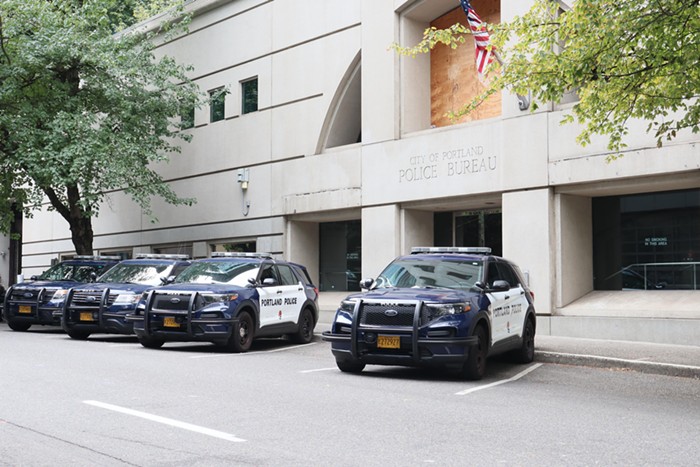On May 22, neighbors around North Mississippi Avenue declared victory after successfully sending developers of a new mixed-use condo project back to the drawing board. Neighbors' complaints over the Mississippi Avenue Lofts' size—it's a four-story building—swayed the city's Historical Landmarks Commission.
The problem is that projects like the Mississippi Avenue Lofts are exactly the sort of thing we need more of in Portland: dense, multi-family housing on transit-oriented streets. Not only do projects like this help alleviate sprawl and use resources in an environmentally sustainable way, but they also help keep housing prices in check, citywide. Those are noble, progressive, urban causes—and yet neighbors throw a wrench into the works when they only care about what's happening in their own backyards.
SIZE MATTERS?
"The height of the building is the primary reason of objection," wrote neighbor Carol Otis, who co-owns the historic John Palmer House, which is half a block north of the proposed Lofts' site. "The height will allow people to directly look in our windows, front yard, detract from privacy, and will block sun."
Height has been the number-one concern for neighbors surrounding the proposed Mississippi Avenue Lofts (though neighbors round out their objections with concerns about a loading zone—the width of the sidewalk—and how the developers went about notifying neighbors regarding project meetings and discussions).
Neighbors with height concerns also sent notes to the city's Bureau of Development Services.
"This four-story building will be two stories higher than any other structure in the historic district," and "will limit light and views for neighbors," one neighbor wrote. Another said the "HUGE" building would be a detriment to "privacy, views, and sunlight for all surrounding properties."
A letter signed by 40 neighbors asked the city to limit the project's height to 40 feet. Current zoning allows for a 45-foot-tall building—and city staff noted in their decision to approve the project that the lofts are "under the height limit"—but neighbors contend that due to a slope on the site, the lofts will max out at 50 feet on one end. They'd like that shaved down to 40 feet.
Neighbors got their way at a May 22 meeting of Portland's Historical Landmarks Commission. After over a dozen neighbors testified against the project—mostly on the basis of the project's size—the board told the developers to meet with the neighbors and come back with modifications on June 12. (Neighbors quickly sent out a "Victory!" email.) Hopefully, the setback won't derail the project entirely.
Ironically, neighbors also complained in their petition to the city that the "Mississippi Lofts are not affordable to Boise [neighborhood] residents," and demand that the smallest loft units be priced at $180,000 (currently, they're slated to start in the "mid $200,000s").
What the loft opponents fail to realize, however, is that obstructionism like theirs is a major cause of higher urban housing prices. To be sure, the price of a single-family home in the Boise neighborhood has skyrocketed—homes currently on the market in the neighborhood range from $249,000 to half a million dollars—and that's not the fault of the politically active neighbors. But standing in the way of new housing will do more than preserve views and privacy—it will make the cost of housing go even higher.
WHY YOUR HOUSE COSTS SO MUCH
Portland, like many other US cities, can't afford to let housing prices rise unchecked. According to an analysis by the Seattle Post-Intelligencer, 29 percent of people living in Multnomah County have income twice below the federal poverty level. The Economist recently named Portland as the third least affordable city in the US, because our incomes can't keep up with rising costs of living, including housing. Homes in Portland are appreciating at the rate of 19 percent a year. The median Portland home price is currently $269,500.
The conflict over the project on Mississippi is another example of the sort of neighborhood-level anti-development fight that's happening all across Portland over tall mixed-use projects, skinny houses, and infill. And the Lofts certainly aren't a panacea for housing prices—a low-income family in Portland will not be able to afford a home there. But building more housing like this—dense, and in neighborhood commercial zones—is one way to keep the cost of housing in surrounding areas from rising exponentially.
There are other things that city leaders can do to ensure that Portland's working- and middle-class families aren't pushed out of the city. For starters, political leaders can make sure schools, public safety, parks, and other basics are well funded, while taxes remain affordable.
But the one thing residents can do is look at the big picture: Accept the idea of a four-story building—even if it will block the light and views in your adjacent city lot—for the sake of your neighborhood and the city at large.
NIMBYs VS. A BETTER PORTLAND
Building bigger, taller projects on neighborhood commercial strips like Mississippi, Alberta, Hawthorne, Belmont, Division, MLK, and Grand is the right thing to do. Encouraging these projects in retail districts—where they complement the already bustling urban landscape, and make the smallest impact on single-family zones—strikes a perfect balance between density and livability.
And multi-family projects help to mitigate housing prices. Theoretically, homes could sell for a little higher than what they'd cost to construct (the cost of the land plus the cost of the construction, and a small profit for the developer), Edward Glaeser of Harvard and Joe Gyourko of the University of Pennsylvania wrote in a 2002 study. They were trying to figure out why housing in some urban areas is far more expensive than the cost of construction. Their answer? A "zoning tax" ups the price. A "zoning tax" is their term for the web of housing regulations and hurdles developers must jump through (including satisfying neighborhood groups and historic landmark commissions) in order to build.
According to a March profile of Glaeser in The New York Times, "Glaeser speculates that there may be a viral phenomenon whereby once housing prices reach a certain level, residents become aware of high home values and agitate for restrictions; another possibility is that judges have become much more sympathetic to blocking development for environmental reasons," the piece said. "Still another thought: that homeowners, utilizing skills learned during the civil rights movement and political protests of the 1960s and 1970s, became much more adept at organizing against developers. (There appears to be a reasonable correlation between liberal enclaves, zoning regulations, and high housing prices.)"
The economics behind this theory are simple: Increasing the supply of housing will help mitigate demand and keep high prices in check. Multi-family projects do this more efficiently than building swaths of two-story single-family homes.
And offering a diversity of housing choices—in the form of condos, lofts, rowhouses, and apartments—will help the market in other ways. Think of it like this: Every smaller family—like a childless couple, a single person, or empty nesters—willing to move into a multi-family project, is one less bid on that single-family home four blocks away. Fewer bids on the single-family home mean prices don't have to soar over the asking price. In turn, that means existing single-family homes are more affordable to working- and middle-class families. (The same theory applies to rentals: More rental units, even if they're more expensive "market rate" apartments, frees up older, cheaper units.)
GET IN THE ZONE
Harvard's Glaeser argues that abandoning all zoning restrictions isn't the answer—that's taking the problem to the opposite extreme. But cities might look at relaxing regulations, especially in times of high housing prices, to promote building. And neighbors can work more constructively—and less obstructively—with developers to ease the process.
"If policy advocates are interested in reducing housing costs, they would do well to start with zoning reform. Building small numbers of subsidized housing units is likely to have a trivial impact on average housing prices (given any reasonable demand elasticity), even if well-targeted toward deserving poor households. However, reducing the implied zoning tax on new construction could well have a massive impact on housing prices," Glaeser and Gyourko wrote in their study.
The developers of the Mississippi Avenue Lofts went through several rounds of design review with the city, attended every neighborhood meeting for a year, adhered to numerous documents laying out development standards for their lot, and asked for a vote of neighborhood support twice (they also asked for the support of the neighborhood business association).
Throughout the city's approval of the project, city staff notes that all applicable design guidelines and criteria were met—despite neighbors' gripes. There's no minimum-parking requirement for the project, because Mississippi is well served by transit. The views in the neighborhood are not protected, and city staff point out that the project is 220 feet downhill from the John Palmer House—it will not "loom over" that house. And the project is within the height and scale limits for Mississippi (it just happens to be the first one to take full advantage of the four-story limit).
After the developers successfully navigated every process (the second neighborhood vote was in their favor), a small group of neighbors still objected, and ponied up $250 to appeal the city's decision.
"The main basis for the appeal is that [the Lofts] do not reinforce the historic nature of Mississippi Avenue and do not fit into the size, scale, or mass of the existing historic neighborhood," neighbors wrote (again, despite the fact that the Lofts' size, scale, and mass are all well within the area's zoning rules).
That's exactly the sort of over-regulation Glaeser's talking about.


















